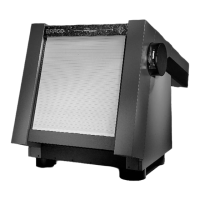Field Service Manual December 2003
Page 182 of 276
The AOM
The beams are reflected by mirror M2 and must be adjusted so that the
beams enter the AOM under the correct angle so that the diffracted
beams follow the center line. The main beams are stopped by the order
blocker. Before entering the AOM the 6 beams must be 200 um to avoid
large rise times (it takes more time for the sound wave to travel through
a thick spot).
One AOM consists out of 6 Bragg cells.
Four modulated signals are applied to each cell of the AOM and for each
incoming beam four partially diffracted beams are generated under
angles proportional to the frequency of the modulated signals.
The intensity of the diffracted beams is proportional to the square of the
amplitude of the modulated signals.
These 24 modulated signals are generated in the Multi Beam Box and
the signals are adjustable in frequency and amplitude. The frequency
and amplitude are controlled by the I2C-bus. The I2C-interface is located
on the MACCON-board.
The beams pass L3 (F83) which is a cylindrical lens with deformation in
the X -direction.
The six main beams are stopped by the Order Blocker and the 24
deflected beams pass the Order Blocker at their sharpest point.
The beams are reflected by mirrors M3 and M4 and pass L4 (F200)
which is a cylindrical lens with deformation in the X-direction.
The beams are reflected by mirror M5 and pass a second order blocker.
The second order blocker is used to cut off the rest light.

